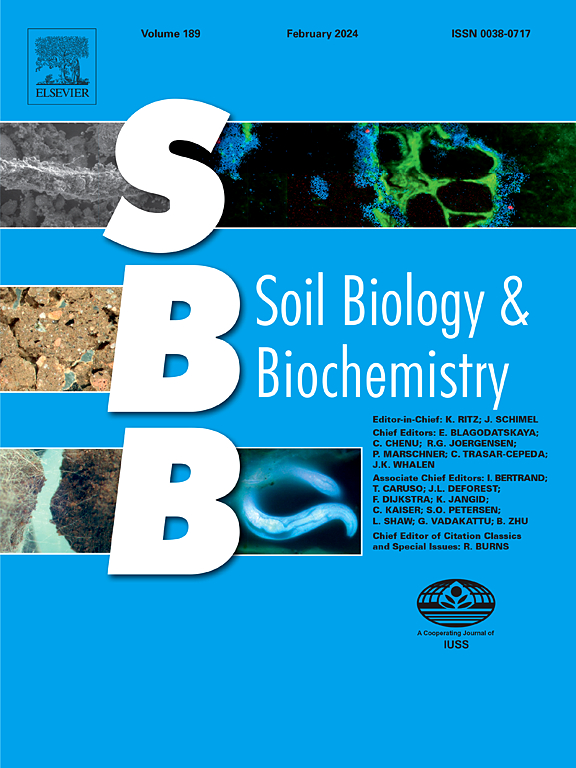探测泵:土壤碳动态、微生物碳利用效率和群落组成对化学计量平衡的堆肥和生物炭的响应
IF 9.8
1区 农林科学
Q1 SOIL SCIENCE
引用次数: 0
摘要
土壤有机质(SOM)的积累受土壤微生物生理生态特性的影响。通过化学计量平衡的输入来改良土壤可以优化微生物资源获取和随后的碳(C)稳定途径。然而,这一机制在实践中运用得很差。废水生物固体可以转化为增值土壤改良剂,使城市环境中的碳和营养物质的平衡比例返回农业生态系统。为了研究新改良土壤中微生物C泵的驱动因素,我们从化学计量理论(CUEST)、呼吸、生理性状、群落结构和土壤C动态等方面对微生物C利用效率进行了建模。方法用等量C的生物固体、生物固体、生物炭或葡萄糖添加无机氮(N)、磷(P)和硫(S)对农业土壤进行改良,使其元素比例与稳定的SOM相似。在温度控制的微环境中培养处理,与不添加C或营养物质的对照组一起培养。分别在0、1、2、3、7、28和56 d测定土壤化学特征、温室气体演化、微生物群落组成和胞外酶。结果一级动力学估计净土壤C为2.60%(对照)、2.54%(葡萄糖+ NPS)、2.93%(堆肥生物固体)和2.92%(生物炭)。与对照相比,土壤C排放量增加了702%(葡萄糖+ NPS), 22%(堆肥生物固体)和203%(生物炭)。CUEST随时间增加(p<0.001),但堆肥生物固体(p<0.001)和葡萄糖+ NPS (p<0.001)对其产生负面影响。在堆肥生物固体(p<0.001, r2 = 0.37)和生物炭(p<0.001, r2 = 0.43)中,CUEST与土壤pH值相关,与微生物多样性呈正相关。结论堆肥生物固体以微生物CUEST为代价保留了最多的土壤C,而生物炭保持了CUEST,但增加了CO2排放。我们提供了微生物C泵的生态生理驱动因素的见解,并揭示了新的土壤改良剂如何以不同的方式优化向土壤生态系统输送C和养分。本文章由计算机程序翻译,如有差异,请以英文原文为准。


Probing the pump: Soil carbon dynamics, microbial carbon use efficiency and community composition in response to stoichiometrically-balanced compost and biochar
The accumulation of soil organic matter (SOM) is influenced by the ecophysiological traits of soil microbes. Amending soils with stoichiometrically-balanced inputs can optimise microbial resource acquisition and subsequent carbon (C) stabilisation pathways. However, this mechanism has been poorly translated into practice. Wastewater biosolids can be transformed into value-added soil amendments that return balanced ratios of C and nutrients from urban environments to agroecosystems. To investigate drivers of the microbial C pump in freshly-amended soils, we modelled microbial C use efficiency from stoichiometry theory (CUEST), respiration, physiological traits, community structure and soil C dynamics. Agricultural soil was amended with an equal C mass from composted biosolids, biosolids biochar or glucose supplemented with inorganic nitrogen (N), phosphorus (P) and sulphur (S), such that element ratios were analogous to stable SOM. Treatments were incubated in temperature-controlled microcosms, alongside a control with no C or nutrients added. Soil chemical characteristics, greenhouse gas evolution, microbial community composition and extracellular enzymes were measured at 0, 1, 2, 3, 7, 28 and 56 days. First order kinetics estimated total soil C at 2.60% (control), 2.54% (glucose + NPS), 2.93% (composted biosolids) and 2.92% (biochar). Soil C emissions increased by 702% (glucose + NPS), 22% (composted biosolids) and 203% (biochar) compared to the control. CUEST increased over time (p < 0.001) but was negatively affected by composted biosolids (p < 0.001) and glucose + NPS (p < 0.001). CUEST was linked to soil pH and correlated positively to microbial diversity for both composted biosolids (p < 0.001, r2 = 0.37) and biochar (p < 0.001, r2 = 0.43). Composted biosolids retained the most soil C, at the cost of microbial CUEST, whereas biochar maintained CUEST, but increased CO2 emissions. We provide insights into ecophysiological drivers of the microbial C pump and reveal how novel soil amendments differentially optimise the delivery of C and nutrients to the soil ecosystem.
求助全文
通过发布文献求助,成功后即可免费获取论文全文。
去求助
来源期刊

Soil Biology & Biochemistry
农林科学-土壤科学
CiteScore
16.90
自引率
9.30%
发文量
312
审稿时长
49 days
期刊介绍:
Soil Biology & Biochemistry publishes original research articles of international significance focusing on biological processes in soil and their applications to soil and environmental quality. Major topics include the ecology and biochemical processes of soil organisms, their effects on the environment, and interactions with plants. The journal also welcomes state-of-the-art reviews and discussions on contemporary research in soil biology and biochemistry.
 求助内容:
求助内容: 应助结果提醒方式:
应助结果提醒方式:


